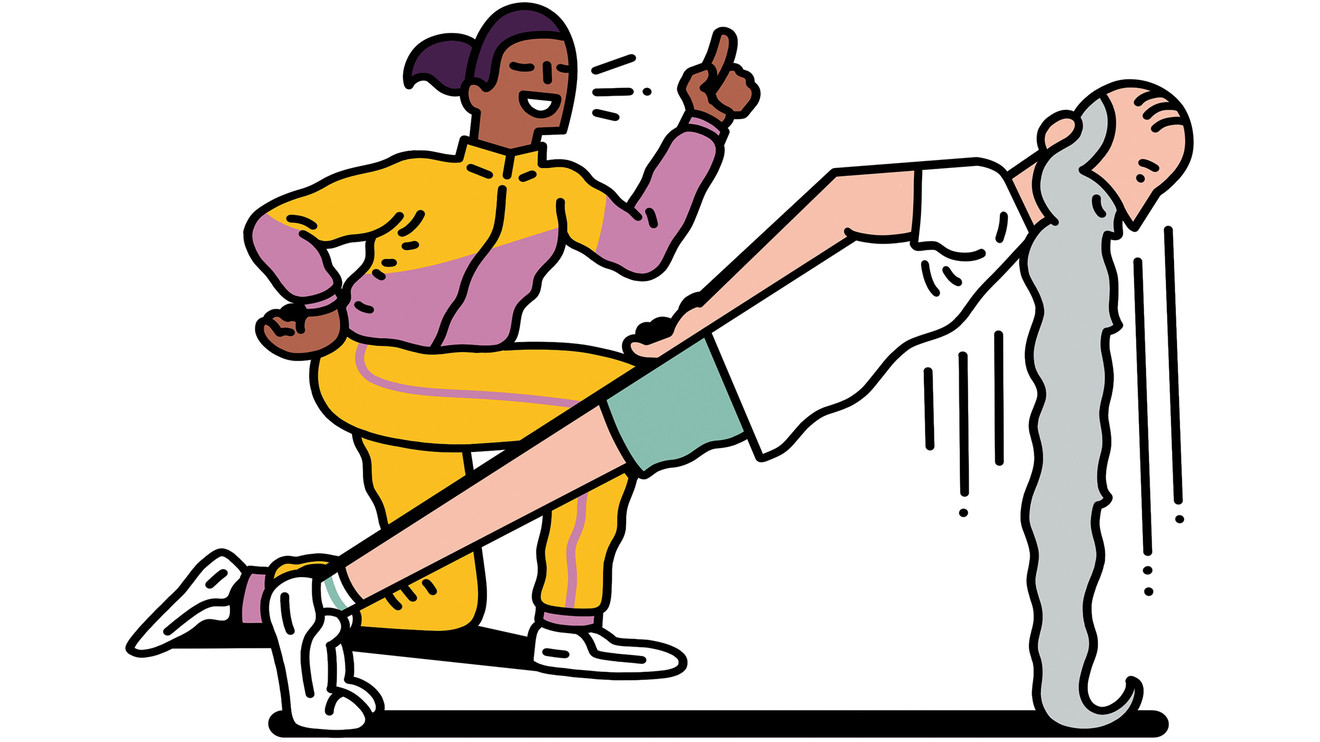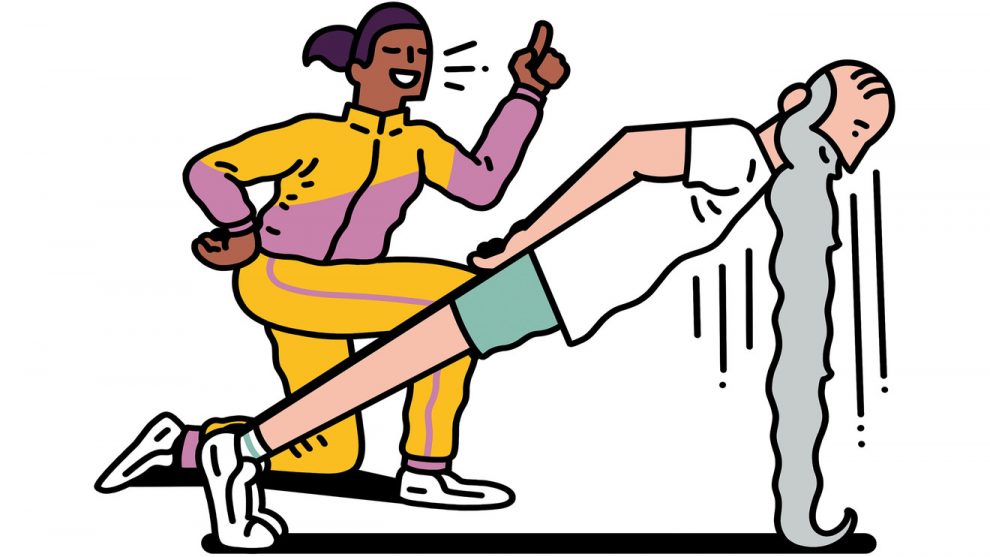
It’s a simple routine: stretches, sit-ups, push-ups, leg raises. Bending. Stooping. It isn’t overly strenuous, but it gets the blood flowing and makes Richard Kane feel a sprightly 70.
Which is terrific, given that Kane is 97.
“I’ve been doing this same, 26-minute routine three or four times a week since the Eisenhower administration,” he says proudly. (That’s the 1950s, folks.)
The former Air Force pilot, who lives in Alexandria, Va., flew during the Berlin Airlift and later served as an intelligence officer, and he’s at the extreme end of a growing wave of Americans who are living longer than prior generations — in some cases far longer.
Call it a “silver tsunami.” Even as the U.S. population as a whole is expanding at its slowest pace in eight decades, the number of older Americans is growing explosively. It isn’t just the 76 million baby boomers between the ages of 55 and 73; there are some 25 million people older than that. And within that group, there are 8 million to 10 million so-called superseniors who, like Kane, are 85 or older.
To illustrate how fast this cohort is growing, consider that in 1950, when America’s population was 150 million, about a million people were at least 85 — just two-thirds of 1% of the population. The Census Bureau says that by 2016 that percentage had nearly tripled to 1.9% of the population, and by 2040, just two decades from now, it will double to 3.8% of the population. Think about that: Nearly one in 25 Americans will be over the age of 85.
So many people are living so much longer, in fact, that “the myth of what being elderly looks like has changed,” says Mike Braham, chief executive officer of Trapollo, a Virginia-based connected-care provider. He says the new image is one of people who are physically active, engaged and focused on finding meaning. Braham calls this combination, for those able to achieve it, a “health dividend” that can last — as it has for Richard Kane — decades.
“I don’t even consider chronological age any more. I don’t know how 86 is supposed to feel, or how I’m supposed to act. The warranty on my body parts may have expired, but I’ll keep going.”
How seniors do two of those things — engage with others and find meaning — can take many forms. It’s the same with staying physically active. But by “physically active,” it’s important to emphasize that this should mean more than just walking.
“Walking is great,” says Dan Ritchie, co-founder of the West Lafayette, Ind.-based Functional Aging Institute, “but it is not sufficient.” Ritchie is 44 and has a Ph.D. in health and kinesiology.
In fact, Ritchie, who is also co-founder of Miracles, a fitness club that focuses on baby boomers and seniors, including those with various medical conditions, advises clients to “think less about fitness itself and more about what you want your life to look like.” He calls this “functional ability.”
“As we age,” he says, “having the functional ability to do basic things can become more challenging. What if you want to get down on the floor to play with a grandchild? Kick a soccer ball in the backyard? Or carry in the groceries?” It is around such basic desires that Ritchie designs his training programs.
“I have clients that can do push-ups and scamper around,” he says.
One of them is 86-year-old Joyce Field, who began training at age 78. Think you can handle her Monday-Wednesday-Friday routine? It begins with a 30-minute warm-up: a cross-trainer machine, ab exercises, stretches and wall push-ups.
Then the actual workout begins, with her trainer, Johnny, mixing it up each time.
“I do mountain climbers for cardio. Resistance bands, weight machines, and work on my balance,” she says. There are also squats and burpees. “Just did 45 today.” On birthdays, she really pushes herself: one rep of everything for her age.
And she finishes with 60-second planks, with a 45-pound weight on her back — three reps.
Just to repeat, she’s 86.
By the way, all those mountain climbers and squats that Field does make it far less likely that she will fall, a common senior fear. The risk of falling grows with age, because after 40 or so, we tend to lose about 1% of muscle mass each year. Decades later, leg muscles can atrophy to the point where some seniors can topple over — and be forced to rely on a walker. Things like yoga and tai chi also help people avoid future balance issues.
And talk about gratifying: once a month Field visits a massage therapist, who says her muscle tone is better than many clients half a century younger.
“I don’t even consider chronological age anymore,” the octogenarian says. “I don’t know how 86 is supposed to feel, or how I’m supposed to act. The warranty on my body parts may have expired, but I’ll keep going.”
One example of just how many seniors have decided to keep on going — and going — is reflected in the number of them doing triathlons, which comprise back-to-back-to-back swimming, biking and running. According to data provided by Colorado-based U.S.A. Triathlon, the national governing body for triathlons and other multisport disciplines, the number of Americans age 70 or older who participated in officially sanctioned “tris” (covering races of varying distances) grew 168% between 2009 and 2017.
This is more than a health and fitness story, though. It is also a growing business opportunity for health-care entrepreneurs. “Most health clubs are not built for the over-60 crowd,” Ritchie says, despite the fact that “older clients are willing to pay more” to attend a fitness facility in which they can feel comfortable. That’s often not the case with big-box gyms, where rock music may be blaring as millennials and other younger members do their thing. Ritchie predicts smaller, boutique clubs will spring up to accommodate the booming senior population.
Meantime, staying healthy doesn’t come cheap, but it’s a bargain compared with the alternative. Field, for example, shells out up to $500 a month for her thrice-weekly workouts. That’s a lot, but she points out that she has no major medical issues, and her blood pressure consistently hovers around a healthy 115/70. She had a hip replacement at age 72, which spurred her to begin working out, and “I am not,” she vows, “going to have another one.”
By 2040, nearly 1 in 25 Americans will be over the age of 85.
But while she can afford a nice health club, the fact is many seniors don’t have an extra $500 lying around each month. Those who don’t may want to explore whether nearby community centers or local colleges have programs or facilities that can be accessed for considerably less. Seniors can also band together and hire trainers for more affordable group classes. One possibility is Silver Sneakers, a lower-cost exercise program that is available at 16,000 locations nationwide — and is included with many Medicare plans.
And, of course, exercise is only one part of the health challenge. In addition to working out on a regular basis, seniors like Kane and Field share another common behavior: They eat well. Plant-based diets are good. Processed foods? They’re best avoided.
Kane relishes what he jokes is his “go-to-hell breakfast” — a big salad bowl filled with fruit. For Field: eggs, avocado, homemade bread, with apples, kiwis and oranges. Kane skips lunch; Field opts for salad with grilled chicken. Both emphasize fish or seafood for dinner. Both avoid carbs and drink lots of water, though in the evening Kane treats himself to a cocktail or two. “I am infamous for my Manhattans,” he says, so much so that when he and his daughter go to their favorite restaurant (they walk), “I walk in, and they don’t even have to ask.”
Kane is a longtime patient of Dr. Foster Montalbano, of Inova VIP 360, who has practiced internal medicine in the Washington, D.C., area for more than 30 years. Of his senior patients, he says, “they’re aware that there’s a delta between the way they think and the way their body behaves. They eat little and exercise regularly.”
He has another key guideline: Avoid social isolation. Montalbano says single seniors — who number in the millions — especially need to get out of the house and interact with others. “If you’re churchgoing, there’s evidence you’ll live longer, just because of the support network,” he points out. “Even owning a pet helps. But find something to do that gives you pleasure and brings you into contact with others.”
Kane, Field and other super seniors get this; they understand the value — and sheer enjoyment — of being sociable.
Kane’s advice: “Be happy. One of my friends says, ‘I never see you without a smile.’ ”









